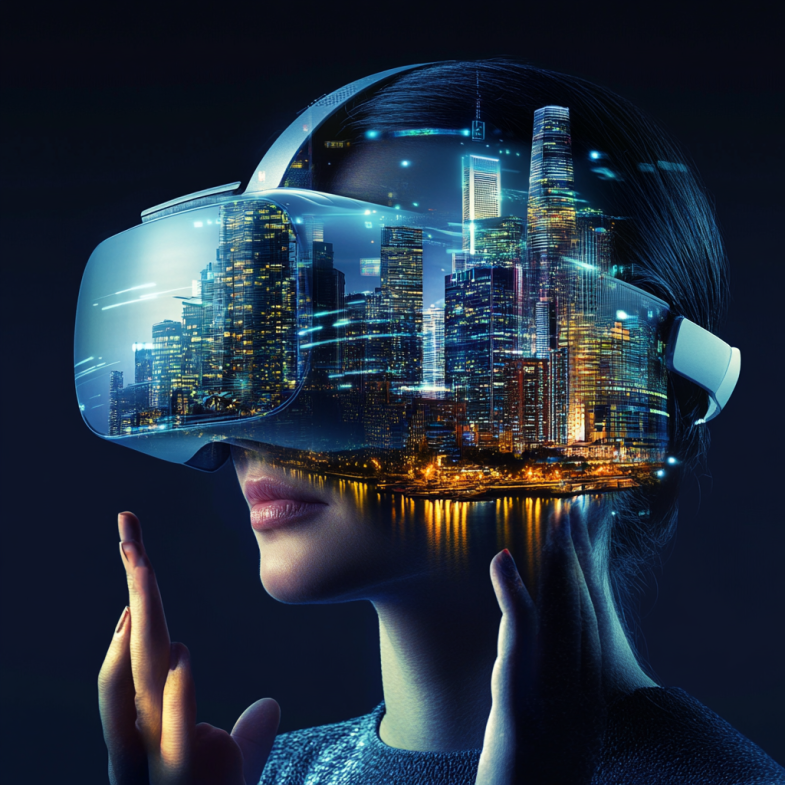Virtual reality (VR) and augmented reality (AR) technologies are rapidly developing and finding more and more applications in various fields. These technologies open up new horizons for education, entertainment, and improving the quality of life. In this article, we will look at what VR and AR are, what are their advantages and disadvantages, and how they are used in education and entertainment.
Chapter 1: What is Virtual and Augmented Reality?
Defining VR and AR
Virtual reality (VR) is a technology that creates a completely artificial environment that the user can immerse themselves in using special devices such as helmets or glasses. The user can interact with this environment, feeling like a part of the virtual world.
Augmented reality (AR) is a technology that adds digital elements to the real world. Unlike VR, AR does not replace the environment, but complements it, allowing users to see virtual objects through the screen of a smartphone, tablet, or special glasses.
Differences between VR and AR
The main difference between VR and AR is that VR creates a completely artificial environment, while AR adds digital elements to the real world. For example, the game Pokémon GO uses AR to show virtual creatures in a real environment, while VR games completely immerse the user in a virtual world.
Chapter 2: Advantages and Disadvantages of VR and AR
Advantages
Immersion: One of the main advantages of VR is the ability to fully immerse the user in a virtual world. This is especially useful for gaming applications and educational programs, where users can experience realistic situations that cannot be reproduced in the real world.
Interactivity: VR and AR provide a high level of interactivity, allowing users to interact with virtual objects and environments. This makes learning more interesting and engaging, and allows for hands-on training in a safe environment.
Personalization: These technologies can be tailored to the specific needs of users. For example, in educational programs, customized learning materials can be created that are tailored to the level of each student.
Disadvantages
High Cost: One of the main disadvantages of VR and AR is the high cost of equipment and content development. Specialized devices such as helmets and glasses can be quite expensive, which limits the availability of these technologies to the masses.
Technical Limitations: Some users may experience discomfort when using VR devices, such as dizziness or nausea. In addition, the graphics quality and performance of the devices may not always meet user expectations.
Hardware Dependency: To fully use VR and AR, special equipment is required, which may be inconvenient or difficult to operate. This may limit the use of these technologies in everyday life.
Chapter 3: Application of VR and AR in Education Interactive Learning
One of the most promising areas of application of VR and AR in education is interactive learning. With the help of these technologies, students can immerse themselves in virtual laboratories, historical eras, or space travel, which makes the learning process more exciting and memorable. For example, VR programs can allow students to study human anatomy by exploring virtual organs and systems.
Training and Simulations
VR and AR can also be used to conduct practical training and simulations. For example, future doctors can practice surgeries in a virtual environment, and pilots can train on virtual flight simulators. This allows them to gain valuable experience without risking health and safety.
Personalized Curriculums
These technologies allow for the creation of personalized curricula that are tailored to the level of each student. For example, the system can analyze a student’s progress and offer them tasks that will help them improve their skills and knowledge. This contributes to more effective learning and improved academic performance.
Chapter 4: Using VR and AR in Entertainment Gaming Applications
One of the most popular areas of application for VR and AR is gaming applications. These technologies allow for the creation of unique and engaging games that completely immerse the user in a virtual world. For example, VR games can allow players to roam fantasy worlds, fight enemies, or solve puzzles.
Virtual Tours and Events
VR and AR can be used to create virtual tours and events that allow users to visit landmarks and events while at home. For example, VR tours can allow people to explore museums, parks, and cities around the world, while AR techology can add additional information to real objects, making excursions more informative and interesting.
Social interactions
VR and AR can also be used to create social platforms where users can communicate with each other in a virtual environment. For example, VR chats can allow people to meet and communicate in virtual rooms, while AR applications can add virtual characters to real environments, creating new opportunities for communication and entertainment.
Virtual and augmented reality technologies have great potential to improve education and entertainment. They allow the creation of interactive and immersive environments that make the learning process more interesting and engaging, and entertainment more exciting and realistic. However, for these technologies to be fully implemented, a number of technical and economic issues need to be addressed, such as the high cost of equipment and content development.


